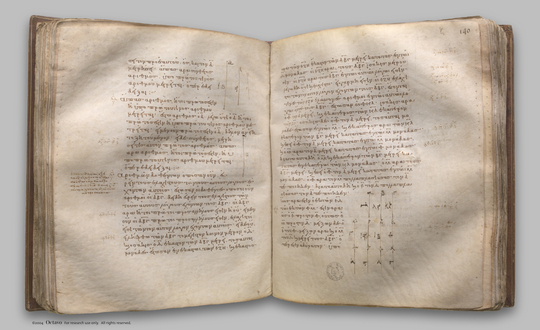index prev next | digilib folio 144

Given as many numbers as we please, to find the least of those which have the same ratio with them.
| Ἀριθμῶν δοθέντων ὁποσωνοῦν εὑρεῖν τοὺς ἐλαχίστους τῶν τὸν αὐτὸν λόγον ἐχόντων αὐτοῖς. Ἔστωσαν οἱ δοθέντες ὁποσοιοῦν ἀριθμοὶ οἱ Α, Β, Γ: δεῖ δὴ εὑρεῖν τοὺς ἐλαχίστους τῶν τὸν αὐτὸν λόγον ἐχόντων τοῖς Α, Β, Γ. Οἱ Α, Β, Γ γὰρ ἤτοι πρῶτοι πρὸς ἀλλήλους εἰσὶν ἢ οὔ. εἰ μὲν οὖν οἱ Α, Β, Γ πρῶτοι πρὸς ἀλλήλους εἰσίν, ἐλάχιστοί εἰσι τῶν τὸν αὐτὸν λόγον ἐχόντων αὐτοῖς. Εἰ δὲ οὔ, εἰλήφθω τῶν Α, Β, Γ τὸ μέγιστον κοινὸν μέτρον ὁ Δ, καὶ ὁσάκις ὁ Δ ἕκαστον τῶν Α, Β, Γ μετρεῖ, τοσαῦται μονάδες ἔστωσαν ἐν ἑκάστῳ τῶν Ε, Ζ, Η. καὶ ἕκαστος ἄρα τῶν Ε, Ζ, Η ἕκαστον τῶν Α, Β, Γ μετρεῖ κατὰ τὰς ἐν τῷ Δ μονάδας. οἱ Ε, Ζ, Η ἄρα τοὺς Α, Β, Γ ἰσάκις μετροῦσιν: οἱ Ε, Ζ, Η ἄρα τοῖς Α, Β, Γ ἐν τῷ αὐτῷ λόγῳ εἰσίν. λέγω δή, ὅτι καὶ ἐλάχιστοι. εἰ γὰρ μή εἰσιν οἱ Ε, Ζ, Η ἐλάχιστοι τῶν τὸν αὐτὸν λόγον ἐχόντων τοῖς Α, Β, Γ, ἔσονται [ τινες ] τῶν Ε, Ζ, Η ἐλάσσονες ἀριθμοὶ ἐν τῷ αὐτῷ λόγῳ ὄντες τοῖς Α, Β, Γ. ἔστωσαν οἱ Θ, Κ, Λ: ἰσάκις ἄρα ὁ Θ τὸν Α μετρεῖ καὶ ἑκάτερος τῶν Κ, Λ ἑκάτερον τῶν Β, Γ. ὁσάκις δὲ ὁ Θ τὸν Α μετρεῖ, τοσαῦται μονάδες ἔστωσαν ἐν τῷ Μ: καὶ ἑκάτερος ἄρα τῶν Κ, Λ ἑκάτερον τῶν Β, Γ μετρεῖ κατὰ τὰς ἐν τῷ Μ μονάδας. καὶ ἐπεὶ ὁ Θ τὸν Α μετρεῖ κατὰ τὰς ἐν τῷ Μ μονάδας, καὶ ὁ Μ ἄρα τὸν Α μετρεῖ κατὰ τὰς ἐν τῷ Θ μονάδας. διὰ τὰ αὐτὰ δὴ ὁ Μ καὶ ἑκάτερον τῶν Β, Γ μετρεῖ κατὰ τὰς ἐν ἑκατέρῳ τῶν Κ, Λ μονάδας: ὁ Μ ἄρα τοὺς Α, Β, Γ μετρεῖ. καὶ ἐπεὶ ὁ Θ τὸν Α μετρεῖ κατὰ τὰς ἐν τῷ Μ μονάδας, ὁ Θ ἄρα τὸν Μ πολλαπλασιάσας τὸν Α πεποίηκεν. διὰ τὰ αὐτὰ δὴ καὶ ὁ Ε τὸν Δ πολλαπλασιάσας τὸν Α πεποίηκεν. ἴσος ἄρα ἐστὶν ὁ ἐκ τῶν Ε, Δ τῷ ἐκ τῶν Θ, Μ. ἔστιν ἄρα ὡς ὁ Ε πρὸς τὸν Θ, οὕτως ὁ Μ πρὸς τὸν Δ. μείζων δὲ ὁ Ε τοῦ Θ: μείζων ἄρα καὶ ὁ Μ τοῦ Δ. καὶ μετρεῖ τοὺς Α, Β, Γ: ὅπερ ἐστὶν ἀδύνατον: ὑπόκειται γὰρ ὁ Δ τῶν Α, Β, Γ τὸ μέγιστον κοινὸν μέτρον. οὐκ ἄρα ἔσονταί τινες τῶν Ε, Ζ, Η ἐλάσσονες ἀριθμοὶ ἐν τῷ αὐτῷ λόγῳ ὄντες τοῖς Α, Β, Γ. οἱ Ε, Ζ, Η ἄρα ἐλάχιστοί εἰσι τῶν τὸν αὐτὸν λόγον ἐχόντων τοῖς Α, Β, Γ: ὅπερ ἔδει δεῖξαι. | Given as many numbers as we please, to find the least of those which have the same ratio with them. Let A, B, C be the given numbers, as many as we please; thus it is required to find the least of those which have the same ratio with A, B, C. A, B, C are either prime to one another or not. Now, if A, B, C are prime to one another, they are the least of those which have the same ratio with them. [VII. 21] But, if not, let D the greatest common measure of A, B, C be taken, [VII. 3] and, as many times as D measures the numbers A, B, C respectively, so many units let there be in the numbers E, F, G respectively. Therefore the numbers E, F, G measure the numbers A, B, C respectively according to the units in D. [VII. 16] Therefore E, F, G measure A, B, C the same number of times; therefore E, F, G are in the same ratio with A, B, C. [VII. Def. 20] I say next that they are the least that are in that ratio. For, if E, F, G are not the least of those which have the same ratio with A, B, C, there will be numbers less than E, F, G which are in the same ratio with A, B, C. Let them be H, K, L; therefore H measures A the same number of times that the numbers K, L measure the numbers B, C respectively. Now, as many times as H measures A, so many units let there be in M; therefore the numbers K, L also measure the numbers B, C respectively according to the units in M. And, since H measures A according to the units in M, therefore M also measures A according to the units in H. [VII. 16] For the same reason M also measures the numbers B, C according to the units in the numbers K, L respectively; Therefore M measures A, B, C. Now, since H measures A according to the units in M, therefore H by multiplying M has made A. [VII. Def. 15] For the same reason also E by multiplying D has made A. Therefore the product of E, D is equal to the product of H, M. Therefore, as E is to H, so is M to D. [VII. 19] But E is greater than H; therefore M is also greater than D. And it measures A, B, C: which is impossible, for by hypothesis D is the greatest common measure of A, B, C. Therefore there cannot be any numbers less than E, F, G which are in the same ratio with A, B, C. |